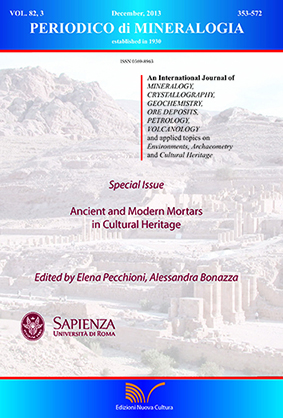Hydraulic mortar and problems related to the suitability for restoration
DOI:
https://doi.org/10.2451/2013PM0031Keywords:
hydraulic restoration mortar, properties, porosimetry, durability, compatibility.Abstract
Restoration mortars for use in hystorical buildings should fullfill compatibility critera with respect to the preexisting materials, in order to ensure harmlessness and effectiveness of the restoration solutions. Nevertheless, a satisfactory evaluation of the suitability of the mortars for restoration is quite difficult due to the lack of proper standards of reference for the specific needs in the field of the Cultural Heritage, as well as for the lack of threshold parameters for the evaluation of the compatibility with the preexisting materials. This paper describes the study for the set-up of an hydraulic mortar for restoration, specifically for masonry rendering. The mortar was designed for applications on soft and porous calcareous stones. The mix was based on natural hydraulic lime (NHL) added with metakaolin. Grinded dolomitic limestones were used as aggregate, and several admixtures with different functions were added. The experimental activity concerning the characterisation of the mortar was carried out on fresh and hardened samples. The standard specifications for the renovation mortars, that meet some suitable requirements for restoration, were assumed as reference parameters for the mortar design and its qualification in terms of density, water vapour permeability, water absorption by capillary action, flexural and compressive strengths. Attention was paid to the porosimetric characteristics, that were determined by Mercury Intrusion Porosimetry. The durability was also assessed by salt ageing test. The behavior of the mortar with respect to some soft and porous calcarenites was also concerned by the adhesive test on composite mortar/stone specimens. Tests of evaporation of Na2SO4 saline solution were also performed on the mortar/stone system, in order to assess the harmlessness of the mortar layers with respect to the transport of the saline solution and to the effects of the salt crystallization at the interface. Finally, an overall evaluation of the performance of the mortar was traced on the basis of the results of the analyses and tests.


